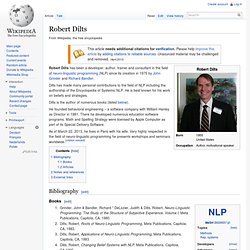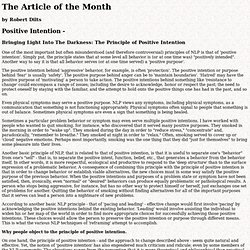

Robert Dilts. Robert Dilts has been a developer, author, trainer and consultant in the field of neuro-linguistic programming (NLP) since its creation in 1975 by John Grinder and Richard Bandler.

Dilts has made many personal contributions to the field of NLP including the authorship of the Encyclopedia of Systemic NLP. He is best known for his work on beliefs and strategies. Dilts is the author of numerous books (listed below). He founded behavioral engineering – a software company with William Hanley as Director in 1981. There he developed numerous education software programs. As of March 22, 2013, he lives in Paris with his wife. Bibliography[edit] Books[edit] Articles[edit] Notes and references[edit] living educational theory External links[edit] Encyclopedia of NLP. Encyclopedia of NLP. Archive of Articles and Patterns Page. Robert Dilts « Alpha Leadership. Article of the Month Page. By Robert Dilts.

In NLP, the phenomenon of "overlap" has to do with the connections between the senses. We can "overlap" an image and a sound together, for example. Sounds or images may also be overlapped onto feelings. Overlap is possible because our sensory experiences become mixed together in our nervous systems. It is this connecting together of information from the different senses that makes creativity and learning possible.
Experiences which involve an overlap of the senses are usually more rich and powerful than perceiving something through a single sense alone. The process of overlap is used in many NLP processes in order to create or enrich a particular experience. Synesthesia As the phenomenon of overlap demonstrates, not all of our mental experiences are clearly distinguishable in terms of the five senses. In NLP, such a connection is called a synesthesia. Synesthesia links have to do with the mutual influence between sensory representations. Fuzzy Functions References. Article of the Month Page. By Robert Dilts.

Conflict is defined as "a state of disharmony between incompatible or antithetical persons, ideas, or interests. " Psychologically, conflict is a mental struggle, sometimes unconscious, resulting when different representations of the world are held in opposition or exclusivity. Conflicts can occur either between parts of ourselves internally (inner conflict) or externally with others (interpersonal conflict). Internally, conflicts occur between different parts of human experience and at many levels. Conflicts may occur about behaviors, for example. Interpersonally, different individual's maps of reality are sometimes so diverse that "bumps" arise when they attempt to communicate or interact together. Conflicting 'Parts' Sometimes, people experience being "incongruent," in an "inner conflict," "of two minds," or "at odds" with themselves.
"One side of the personality stands for certain wishes, while another part struggles against them and fends them off. According to Freud. Article of the Month Page. By Robert Dilts Bringing Light Into The Darkness: The Principle of Positive Intention One of the most important but often misunderstood (and therefore controversial) principles of NLP is that of 'positive intention'.

Simply put, the principle states that at some level all behavior is (or at one time was) "positively intended". Another way to say it is that all behavior serves (or at one time served) a 'positive purpose'. The positive intention behind 'aggressive' behavior, for example, is often 'protection'. Even physical symptoms may serve a positive purpose. Sometimes a particular problem behavior or symptom may even serve multiple positive intentions. Another basic principle of NLP, that is related to that of positive intention, is that it is useful to separate one's "behavior" from one's "self" - that is, to separate the positive intent, function, belief, etc., that generates a behavior from the behavior itself.
Why people object to the principle of positive intention.